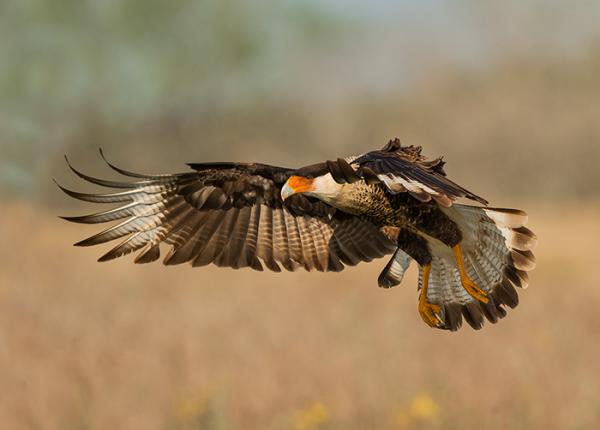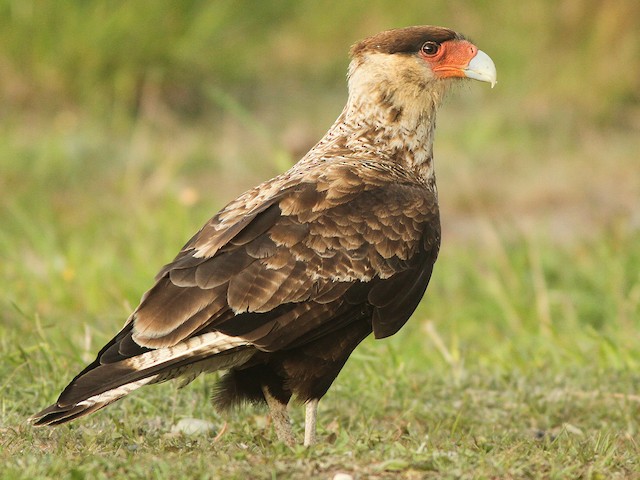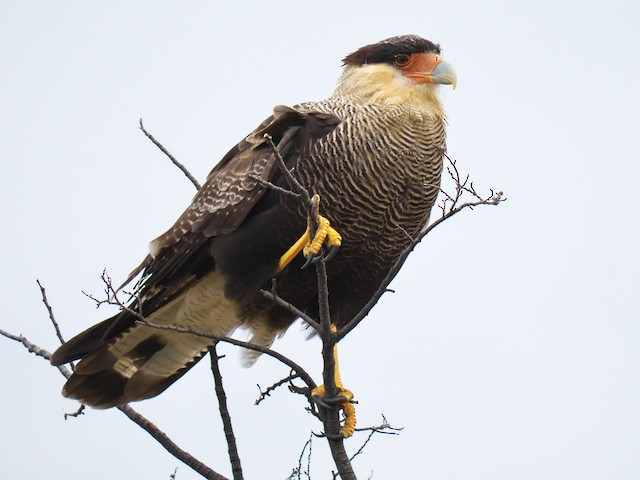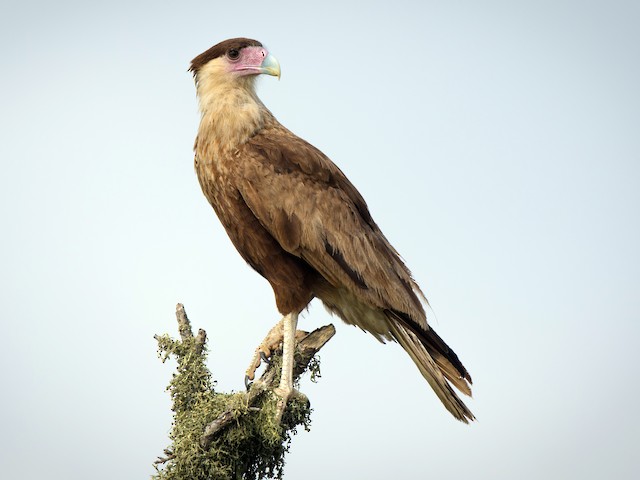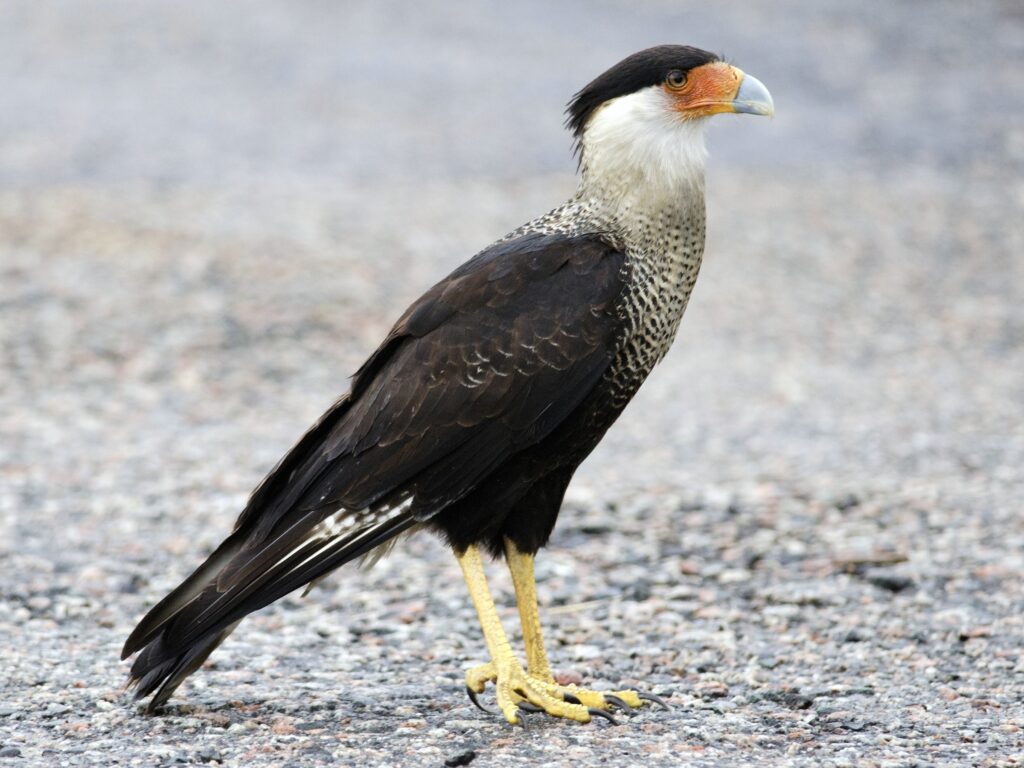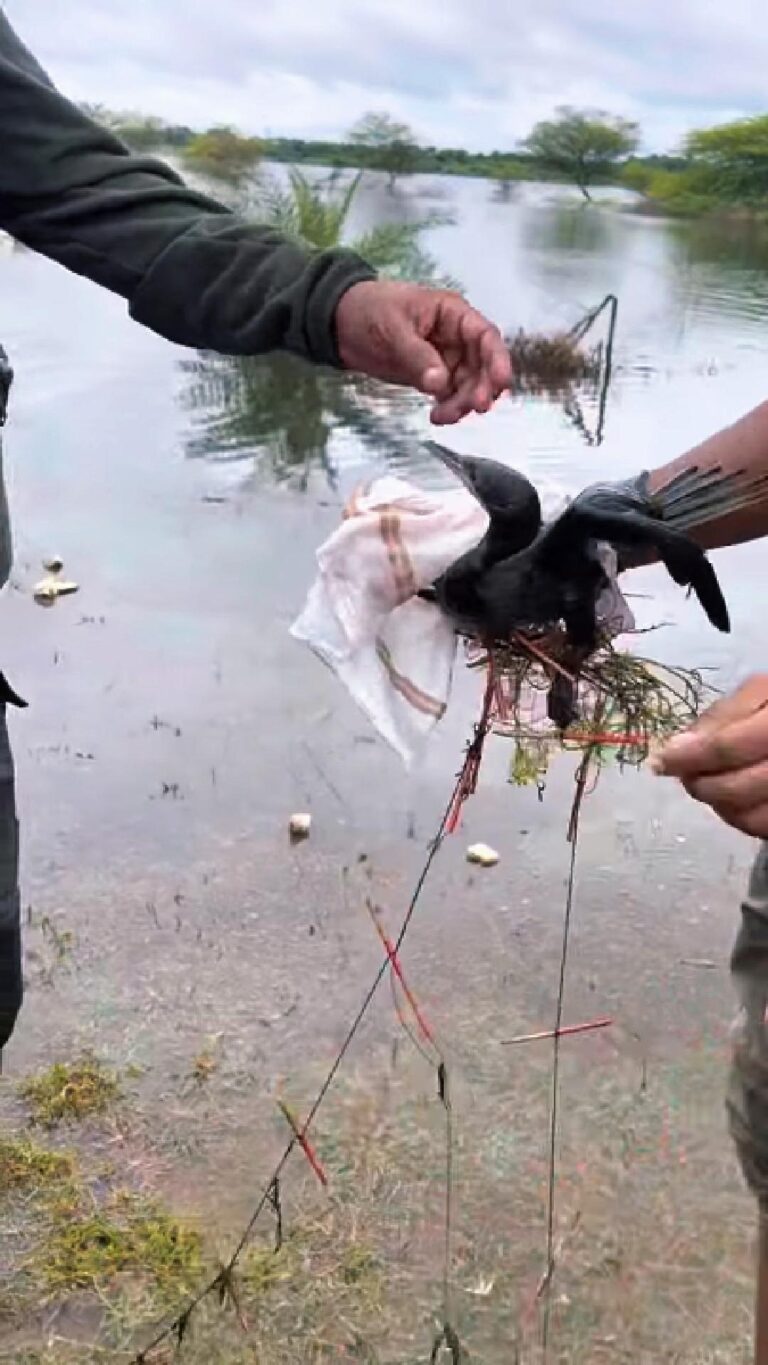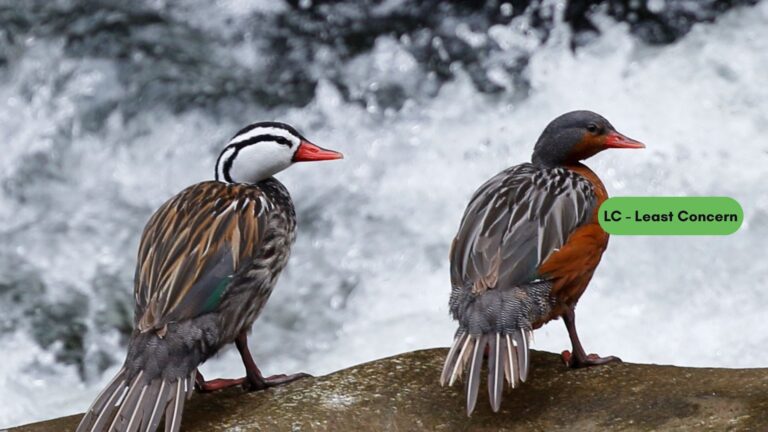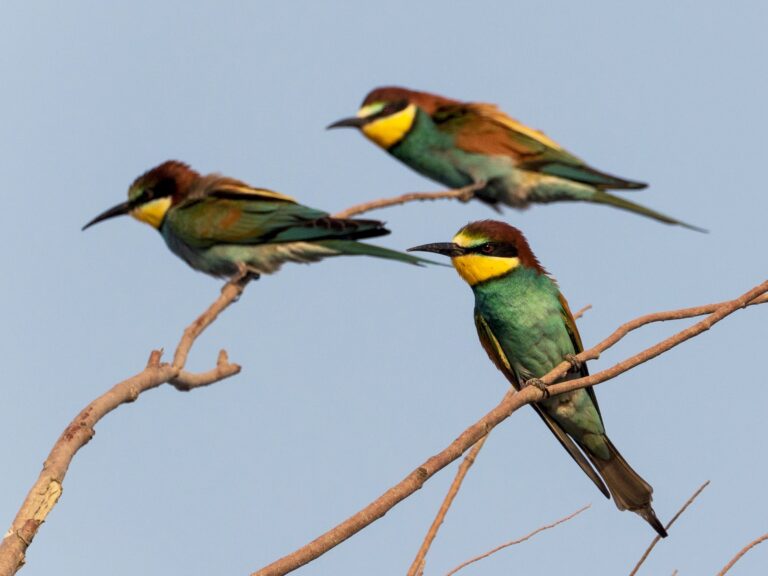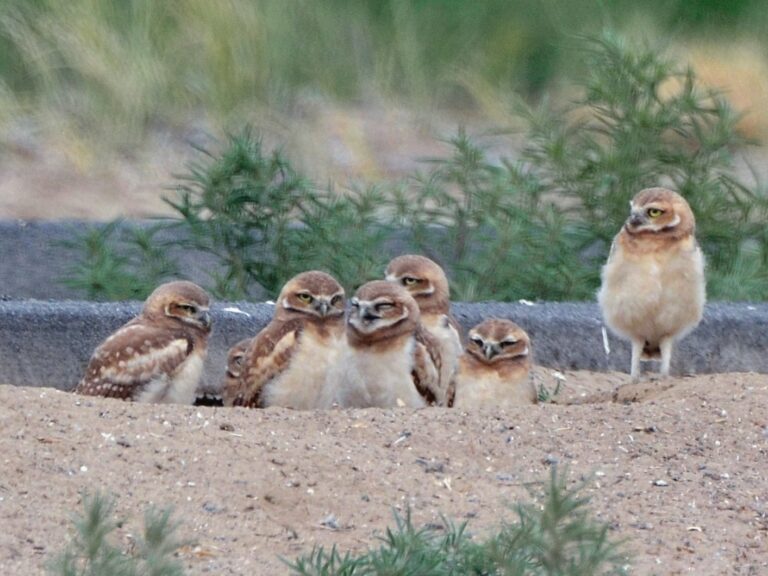Crested Caracara
Introduction
The Crested Caracara has captured the interest of birdwatchers and nature enthusiasts alike, owing to its unique characteristics and behaviors. This article will delve deeper into the various aspects of the Crested Caracara. It offers insights into its ecology, behavior, and significance within its habitat.
The Crested Caracara is a distinctive raptor in the falcon family, found in parts of North, Central, and South America. It measures 19-25 inches long with a 47-52 inch wingspan. This makes it one of the most recognizable birds in its range. This opportunistic scavenger has a black body, white neck, and a bare yellow-orange face, which adds to its striking appearance.
Unlike many raptors that soar high in the sky, the Crested Caracara prefers to inhabit open country. It often walks on the ground, actively searching for carrion and small prey. This showcases its unique foraging behavior.
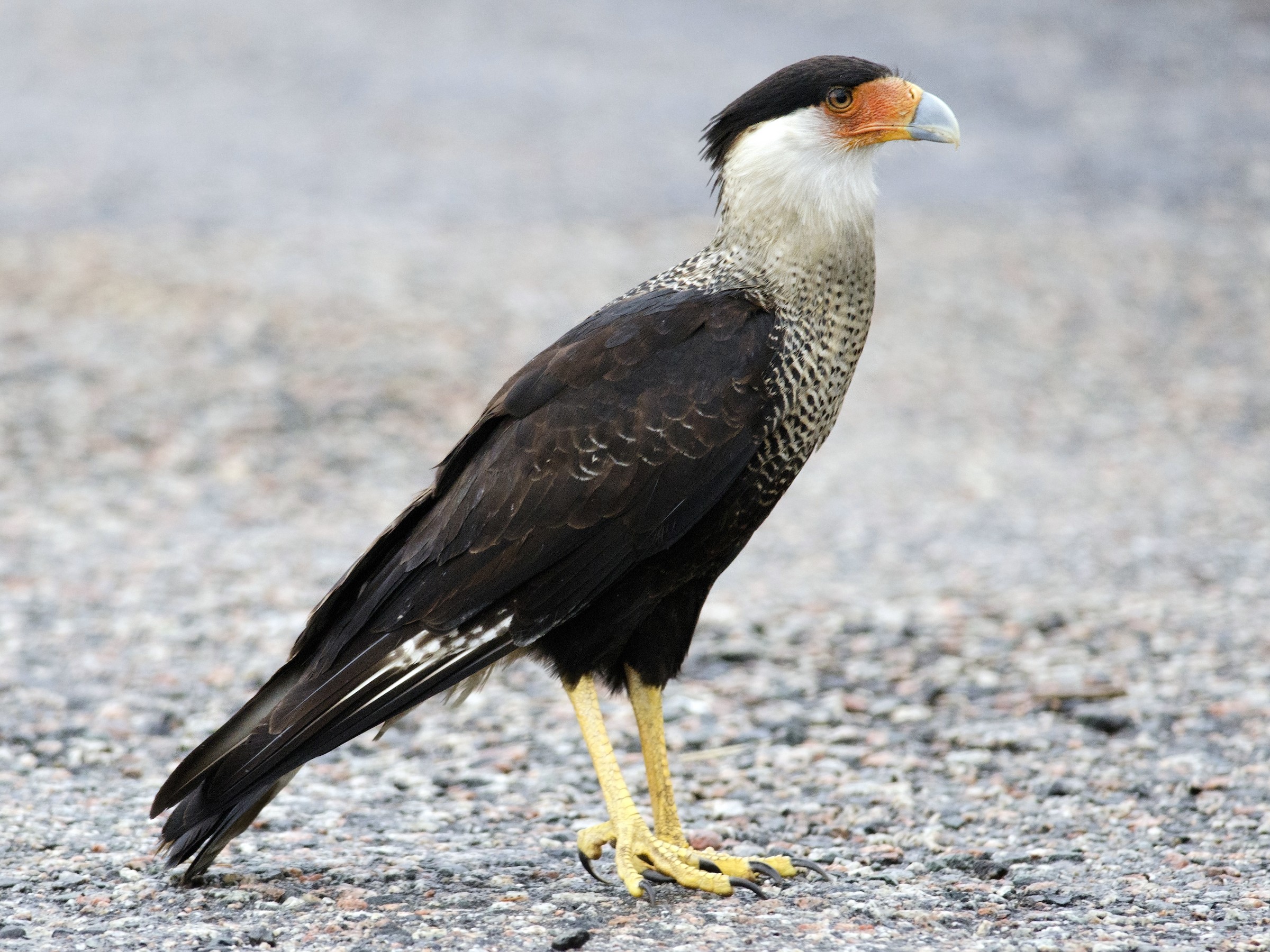
Appearance and Behavior
The Crested Caracara’s physical characteristics are not just visually stunning; they also play a vital role in its survival. Measuring 19-25 inches in length with a wingspan of 47-52 inches, its impressive size makes it an imposing figure.
The bird’s striking black body is complemented by a white neck and throat, which contrast beautifully with its bare yellow-orange face. The black crown, which ends in a short crest, adds further distinction. White patches at the wingtips are particularly noticeable during flight.
Behavioral observations show that Crested Caracaras are often seen walking or running on the ground, a behavior that sets them apart from other raptors that might prefer to remain airborne or perched. This unique foraging technique enables them to cover more ground while searching for food. They often scavenge alongside vultures, taking advantage of their keen eyesight to locate carrion.
Understanding the behavior of Crested Caracaras can provide insights into their ecological role. These birds are not just scavengers; they also exhibit complex social behaviors, often seen in groups, especially when feeding.
Their ability to adapt to different environments and their varied diet contribute to their success as a species. The interactions between Crested Caracaras and other scavengers, such as vultures, are fascinating. They often engage in aerial displays and vocalizations to assert dominance over a food source. This showcases their intelligence and adaptability.
Diet and Feeding Habits
Prey Types
The hunting techniques employed by Crested Caracaras are varied and showcase their adaptability. They often scavenge for carrion, adeptly chasing away vultures from roadkill or other carcasses.
In instances where they hunt live prey, they utilize their strong legs to run after targets, demonstrating notable speed and agility. Additionally, they have been known to steal food from other birds, illustrating their opportunistic nature.
Observations have shown that Caracaras can hunt in pairs, which allows them to tackle larger prey more effectively. This cooperative hunting behavior is an exciting aspect of their ecological role, as it showcases their intelligence and adaptability.
Crested Caracaras are opportunistic feeders with a varied diet, which is essential for their survival in diverse habitats. Their diet primarily consists of carrion from dead animals, but they are also skilled hunters.
They consume small mammals, birds, reptiles, amphibians, fish, insects, and even turtle eggs. This dietary flexibility allows them to thrive in various environments, from grasslands to coastal areas.
Hunting Techniques
These birds often scavenge for carrion and may chase vultures away from roadkill. They also hunt live prey on the ground, using their strong legs to run after targets. Caracaras sometimes steal food from other birds and have been observed hunting in pairs for larger prey.
Reproduction and Nesting
After the eggs hatch, both parents take on the responsibility of nurturing their chicks. They provide food, warmth, and protection, demonstrating a high level of parental care.
The use of clucking sounds and branch-snapping noises serves as a deterrent to potential predators, ensuring the safety of the nest. Remarkably, chicks remain in the nest for about three months before fledging, a period that allows them to grow strong and develop their flight skills.
The reproductive behavior of Crested Caracaras is equally fascinating. During the breeding season, these birds engage in various courtship displays, which may include aerial displays and vocalizations.
Although specific courtship behaviors have not been entirely documented, these displays not only strengthen pair bonds but also serve to establish territory.
Courtship and Mating
Crested Caracaras build large nests made of sticks and vines, often in trees such as palm trees, or occasionally on the ground. Nest construction is a collaborative effort between both parents, highlighting their strong pair bonding.
Females typically lay 2-3 eggs, which are incubated by both parents for 27-33 days. This shared parental investment is crucial for the survival of their young, ensuring they receive adequate care and protection during the vulnerable early stages of life.
Egg Laying and Incubation
Crested Caracaras build large nests made of sticks and vines in trees, often palm trees, or occasionally on the ground. Females typically lay 2-3 eggs.
These eggs are incubated by both parents for 27-33 days.
Nestling Care
Both parents are devoted to caring for their young. They use clucking sounds and branch-snapping noises to deter predators from the nest.
Chicks remain in the nest for about three months before fledging.
Habitat and Distribution
Understanding the habitat preferences and distribution of the Crested Caracara is crucial for conservation efforts. Protecting their habitats ensures the survival of this species, especially in regions where habitat loss and degradation pose significant threats.
Conservation initiatives that focus on maintaining open lands and nesting sites can help support stable populations of Crested Caracaras.
Crested Caracaras inhabit a variety of semi-open environments, including prairies, rangeland, desert areas, and coastal plains. Their habitat preferences include open ground for hunting and dense cover for nesting.
These diverse environments provide the necessary resources for feeding and breeding, which contribute to their population stability.
Despite its current stable status, conservationists emphasize the need for vigilance. Habitat destruction, pollution, and climate change are potential threats that could impact future populations.
Engaging local communities in conservation efforts and promoting awareness about the significance of the Crested Caracara can foster a sense of stewardship towards protecting this unique raptor.
Factors contributing to the success of the Crested Caracara include its adaptability to various habitats and its opportunistic feeding habits. These attributes not only enhance survival but also position them as vital components of the ecosystems they inhabit.
By scavenging, they contribute to the health of the environment, as they help remove carrion that could otherwise spread disease.
Habitat
Moreover, the Crested Caracara plays a crucial role in maintaining ecological balance. As a scavenger, it helps regulate populations of other species by consuming carrion and facilitating nutrient recycling within their habitat.
This ecological function underscores the importance of preserving their populations and habitats for the overall health of the ecosystems they occupy.
The Crested Caracara’s habitat is characterized by its adaptability. They thrive in various semi-open environments, from prairies and rangelands to coastal areas.
They prefer habitats with a mixture of open ground and dense cover, which provides opportunities for hunting and nesting. Their adaptability to different habitats is key to their survival, allowing them to occupy regions that may not support other raptor species.
Distribution
The distribution of the Crested Caracara is impressive, spanning from the southern United States through Mexico and Central America, extending into South America as far as Tierra del Fuego.
Additionally, there are populations in Florida, Cuba, and the Isle of Pines. This broad distribution is indicative of their adaptability and ecological versatility, allowing them to thrive in diverse environments.
Conservation Status
Population Trends
The Crested Caracara is currently listed as Least Concern by the IUCN, indicating that its population is stable.
In the United States, it is protected under the Migratory Bird Treaty Act, which helps safeguard its breeding and feeding habitats. Ongoing monitoring of population trends is essential to ensure that this species continues to thrive.
The Crested Caracara is listed as Least Concern by the IUCN. In the United States, it is protected under the Migratory Bird Treaty Act.
Factors Contributing to Success
The species’ adaptability to various habitats and its opportunistic feeding habits contribute to its success. These factors are essential for its continued survival.
Unique Characteristics
Physical Features
The Crested Caracara possesses distinctive physical features that set it apart from other birds of prey. Its long yellow legs are not just for show; they are a functional adaptation for running and scavenging.
The large hooked bluish bill is perfectly designed for tearing through flesh, making it an efficient scavenger. The unique black and white plumage pattern not only serves as a form of identification but also provides camouflage in its natural habitat, aiding in both hunting and nesting activities.
The Crested Caracara has distinctive long yellow legs, a large hooked bluish bill, and a unique black and white plumage pattern. These features contribute to its effectiveness as a scavenger.
Sensory Abilities
Sensory Abilities
While specific information about the sensory abilities of Crested Caracaras is limited, it is widely understood that raptors possess excellent vision. This is crucial for spotting potential prey or carrion from a distance.
This keen eyesight, combined with their adaptability, enhances their effectiveness as hunters and scavengers. Further studies into their sensory capabilities could provide additional insights into their behavior.
Vocalization
Vocalization
Crested Caracaras produce a distinctive rattling, cackling call, often accompanied by a head-throwback display. This vocalization serves multiple purposes, including communication between mates and signaling territory.
Their calls can be heard during both the breeding season and throughout the year as they assert their presence within their habitat.
Hunting and Flight
While Crested Caracaras are not as fast or agile in flight as other falcons, they compensate for this with remarkable endurance and strong running abilities.
Their hunting strategy often involves a combination of running and flight, allowing them to cover large distances while searching for food. This unique approach to hunting underscores their adaptability and resourcefulness, enabling them to thrive in diverse environments.
Crested Caracaras are not as fast or agile in flight as other falcons. They often hunt on the ground and are strong runners. Their unique adaptations allow them to thrive despite these limitations.
Adaptability
The adaptability of Crested Caracaras is one of their most remarkable traits. These birds have shown incredible versatility, thriving in various habitats, from arid deserts to wet prairies.
They have even adjusted to some human-altered landscapes, indicating their resilience. This adaptability not only enhances their survival prospects but also allows them to exploit a wide range of ecological niches.
These birds have shown remarkable adaptability to various habitats, from deserts to wet prairies. They have even adjusted to some human-altered landscapes, enhancing their survival in changing environments.
